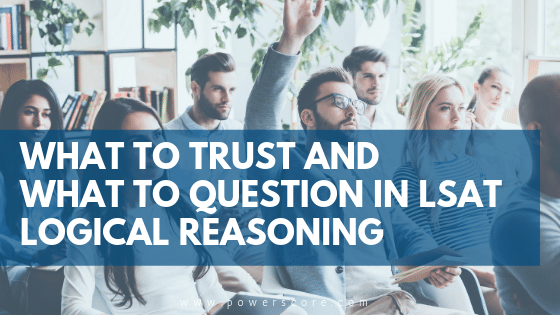One of the most common questions test takers ask when considering LSAT Logical Reasoning is “How do I know what information I can accept as fact?” So let’s consider what information you should question or approach with skepticism.
This very question came up on our Forum. A student considered a question from the second LR section, #24 on the February 1994 LSAT. This question discusses investments and the relationship of inflation to profitability. The student ultimately struggled to make sense of the stimulus because of a multitude of economic considerations not mentioned in the text, but with which the student was familiar.
Truths About the LSAT
I made a few points in response to his questions that I want to echo here. First is a general truth about the LSAT and the second is more specific to LR question types.
- The LSAT is not a subject test. At no point will the test require or expect you to have outside knowledge of a particular subject or concept. Up against a stimulus about the likelihood of comets impacting Earth or a Reading passage about lunar cratering? You absolutely do not need any kind of background in cosmology to succeed! The LSAT tests how you think and react to information, not how familiar you already are with that information. As soon as you feel yourself analyzing concepts/information from your real-world, personal knowledge perspective, hit the brakes! That’s not how this test works. If you filter what you encounter through your own background and insights you’re going to get punished for it. In fact, the test makers know this is a common tendency for people. They put in incorrect answer choices (and I think even choose certain topics) hoping to trick you as you stray from the explicit text.
- In Logical Reasoning you can trust that you’ll be given enough information to determine the correct answer. You can also make very specific determinations about which part of the question can be taken as “true” and used as a means to evaluate the other part. It’s this point that I want to consider further here.
Diving Deeper into Logical Reasoning Part I
There are essentially two types of relationships in Logical Reasoning that the question stem will establish between the stimulus and the answer choices. Let’s examine both types.
In the first, the stimulus will be given to you as true, you will then be asked to evaluate the answer choices based on it. The question I reference in the first paragraph here, a Must be True question, is the most common and probably familiar, of this type. In a Must be True question, the stimulus will provide all the information you need to find the correct answer. You never need to incorporate extra information that the stimulus doesn’t supply or define. Put more succinctly, everything you need is given to you.
All that you must treat with some degree of skepticism in this question type is each answer choice. Seek solely to determine if the answer would follow logically from the truths presented above. Check to see if other question types fit within this construct as well. For example: Main Point, Parallel Reasoning, Method of Reasoning, Flaw in the Reasoning, Point at Issue, and even Cannot be True. Each of these provides a stimulus where the information can be taken as given. Note: this does NOT mean that arguments given in these stimuli are valid! That’s not what I mean by “true.” “True” here simply means that you aren’t looking to refute or correct the stimulus.
Determine what would result from it (Must and Cannot), what best describes it (Main Point, Method, Flaw, and Point at Issue), or what follows the same logical construction as it (Parallel). Accept the specific information in the stimulus and question how that information would apply to each answer choice based on the question stem.
Diving Deeper into Logical Reasoning Part II
The second type of relationship presents a very different scenario. You are given five answer choices each of which you are told is true. Then you must evaluate the effect each answer choice would have on the information in the stimulus, either positively or negatively. I tend to think of questions fitting this mold as either “Help” or “Hurt”. Here the correct answer will not be correct based on what it says the way that a Must be True answer would be. Rather, it will be correct based on what it does.
For Help questions (Strengthen, Assumption, Justify, and Resolve the Paradox), the correct answer will provide details that assist the information in the stimulus in a specified, beneficial way. For Hurt questions (Weaken) the correct answer will give facts that undermine the argument in the stimulus. In either case, again, we are not evaluating the specific contents of the answers. We have to accept the specifics of each and consider the outcome when those specifics are applied to the stimulus. In a sense, asking yourself “what is my opinion of this stimulus/argument when I add this new information to it?”
Study On
Hopefully you can see how crucial it becomes to accurately recognize the different question types and the “true vs questionable” relationship that each establishes between the stimulus and answer choices. Each of the question types above has very specific, very recognizable question stems. Identifying each type on test day can be a straightforward task if you’ve studied them. But, it is a task that is absolutely foundational to your ultimate success on the LSAT. Be sure you can identify each type quickly and accurately before test day.
Need some additional help with Logical Reasoning or another section of the LSAT? We’ve got some of the industry’s best tutors waiting to help you out.



Liana says
thanks for info.